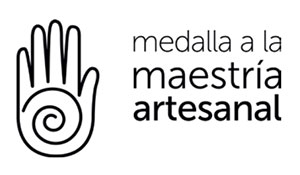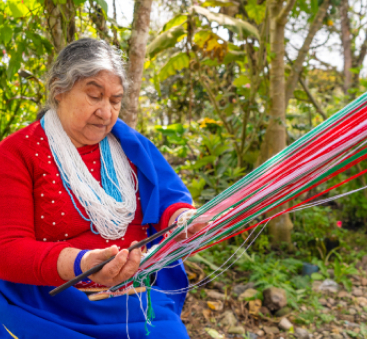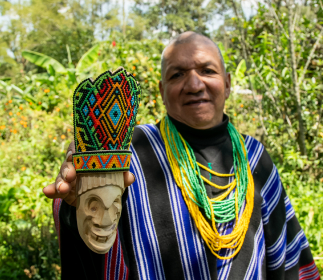Narcisa Chandoy
SCHEDULE YOUR VISIT
Vereda Tamabioy-frente a la vereda Cabrera
3115457141
jabiamnarcisa@gmail.com
We tend to idealize childhood. We have the false belief that everything that happened in our past was beautiful and filled with love. This is, of course, not necessarily true in every case. Narcisa Chindoy was orphaned as a child. She suffered for a long time because of this. She went hungry as well during that time. Like many other children like her, she grew up begging for a place to stay, surrounded by strangers who kept her company: a doctor who adjusted her bones, a storyteller, and an old lady weaver she used to gawk at.
She would watch her weave every day with a strap hanging from a beam. She did not fully understand the process but was amazed by what she saw anyways. She remembers that, if the lady was in a good mood, she would call her over and tell her the meaning of the shapes she was weaving. She and her stories compensated for the fact that she was unable to go to school. This, however, lasted until¬, unfortunately, the lady died too.
She speaks about this without a hint of grief in her voice. Even though she is aware that this tragedy —among many others— happened to her, she also knows that it belongs to a distant past. It, alongside everything else that happened, made her the strong and compassionate person she is today. Her greatest achievement has been to attain the life and family she has now, which are very different from the ones she had before. This she celebrates every day of her life. If need be said, weaving was her salvation. She remembered the old lady and wove as she could. In this way, she amassed enough money to pay for the uniform that was required to get into the nuns’ school.
Afterward, she begged a cousin to teach her some actual weaving techniques. Even though her cousin did not have a lot of patience with her, Narcisa learned out of sheer desire and necessity. She also started writing down the meanings of the symbols she had seen up to that point because she now had to reproduce them herself. She remembers that she made a lot of mistakes and had to undo her wares, but she never thought of giving up: life was hard enough already.
She has devoted her life to writing down every one of the symbols that are woven into the long belts: it is her way of honoring her people’s past and keeping their meanings alive. Through her drawings, she tells the story of the birth of the Sibundoy Valley: the ancient flood that drowned so many people and the arrival of conquistadors and missonaries to these beautiful lands. She also tells of the arrival of the Lord and of His miracles; the devotion her people have for Jesus Christ —for whom they cry and dance—, represented by the cross; and the desire to recover His statue and relics after they were sent far away to Nariño. Likewise, she recalls the story of the little old man who arrived at the house of a very poor woman. She gave him what little she had to eat so that he could have something warm in his stomach, as well as a blanket so he could sleep and continue on his way. The woman was surprised when she woke up and saw her chagra full of hens and all sorts of food. Turns out, the little old man was Jesus all along.
Narcisa says that she was a little girl when she heard these stories, but that she gaped at them with excitement, just like when she heard the music of the Carnival. Every one of these stories made her happy, and, thus, she has woven them with happiness. We were able to see the 30-meter-long woven runners in which these stories were depicted: a moving life experience that invites us to immerse ourselves in its tales.
Craft






Artisans along the way
Artisans along the way
No puede copiar contenido de esta página




































































